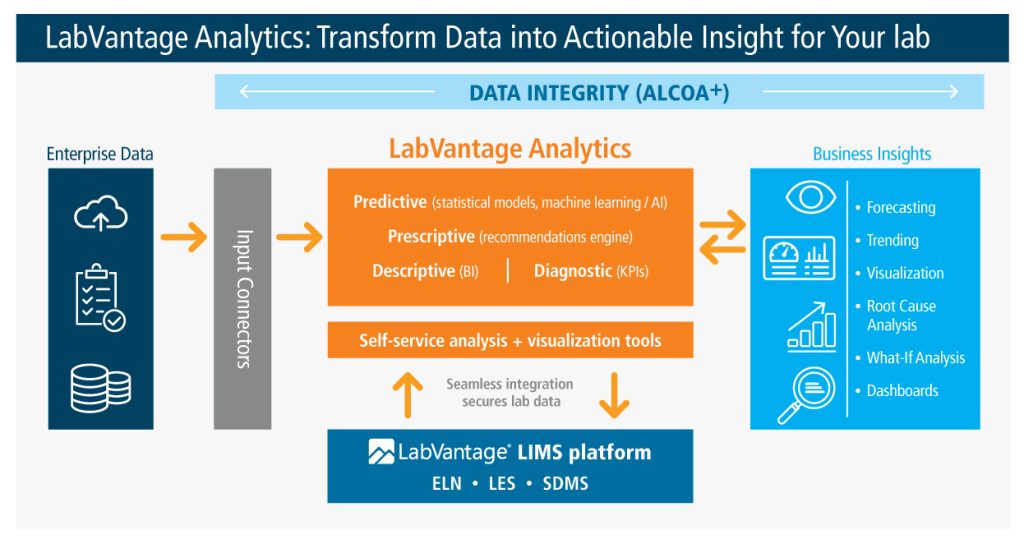 Earlier this month, we published a post on The Lab of the Future, with 5 predictions envisioning the dominance of data, AI, connectivity & collaboration, instrumentation integration and more.
Earlier this month, we published a post on The Lab of the Future, with 5 predictions envisioning the dominance of data, AI, connectivity & collaboration, instrumentation integration and more.
A recent comment to one of our team members caught my attention. It was along the lines of “Hey, that all sounds great! But what about just helping our lab finally escape the use of spreadsheets?”
It’s a good point. Far too many labs continue to exist in a paper-based world. For them, the shift from paper to glass doesn’t necessarily involve AI, mixed reality or extensive automation. When contemplating the initial shift from paper to glass, listening to futurists explore ‘the lab of the future’ can be frustrating.
But the future is coming. (Wow – that’s…deep?)

The point is, technology – and more importantly, data – is changing how we do business. The shift away from physical paper lab notebooks to an ELN, or from Excel spreadsheets to a LIMS, is just the first step – though arguably the most important one – on the digital transformation (DT) journey.
Digital transformation is about more than moving from paper to glass. It’s about the way your lab uses technology and data to build a business ecosystem, thereby reducing risk, accelerating innovation, and driving growth. But with all the hype we’ve seen in recent years — much of it based on speculation and inflated claims — it’s easy to understand why many labs go into the process with unrealistic expectations.
In previous posts we’ve discussed the importance of efficient change management and data strategy, as well as the need to create the kind of data-driven culture required to achieve a successful digital transformation. In this article, we’ll take a closer look at several practical considerations that can make or break your DT success.
Make sure your organization is ready
One of the most common barriers to successful DT is company culture. No matter what your unique business objectives may be, you’ll need to have support at every level of your organization. Strong champions at the top are a great start.
Ideally, you should have a visionary CEO and executive leadership team. These leaders make everything possible, not only by actively supporting your lab’s DT goals, but by empowering those who will take on key transformation roles. They must also be willing to balance the perspective of internal experts (staff with frontline knowledge of the interdependent systems undergoing transformation) and external resources (experts with both domain experience and a record of sustained technological innovation).
One of the trends we’ve observed in companies that have transformed successfully is that they communicate with their staff to help them understand why changes are being made. Their leadership doesn’t just talk about the significance of DT, they demonstrate how it will benefit their teams in order to rally support for their goals.
Know the commitment you’re making
It’s important to understand that digital transformation isn’t a once-and-done process. It’s a state of mind that requires constant adaptation and adoption of new technologies and processes. DT will need to become a constant, dynamic practice if it is to succeed long term.
Good DT strategy needs to be clear enough to drive action, but flexible enough to adapt and scale. Although meeting the challenges of today’s competitive realities is an important part of this process, failsafes against future risks are just as vital, if not more so. Building agility into your digital transformation plan, and regularly evaluating and modifying, when necessary, will empower you to respond to shifting needs and opportunities.
Don’t try to do it all at once
Another common mistake that too many organizations make is trying to get everything done all in one fell swoop. For example, scientists are often excited by the opportunity to work with artificial intelligence and machine learning but try to dive in before they’ve determined how to collect data — or even what data to collect — that will deliver meaningful insights.
Carving your transformation strategy into achievable phases de-risks the whole process by enabling continuous learning and improvement. For example, rather than interfacing all lab instruments to your new LIMS right away, you can selectively interface a few high-volume instruments at a time, measuring your success and tweaking your approach as you go along. This also allows your workforce to adapt to change incrementally, increasing support and adoption.
LabVantage advisors frequently work with senior teams to develop successful implementation strategies, based on which lab functions are best positioned to transition first. For example, many digital transformation strategies start in the R&D lab, where IT can test, configure, and learn from new LIMS technology in a smaller, more manageable environment, then carry those learnings forward to the broader enterprise.



